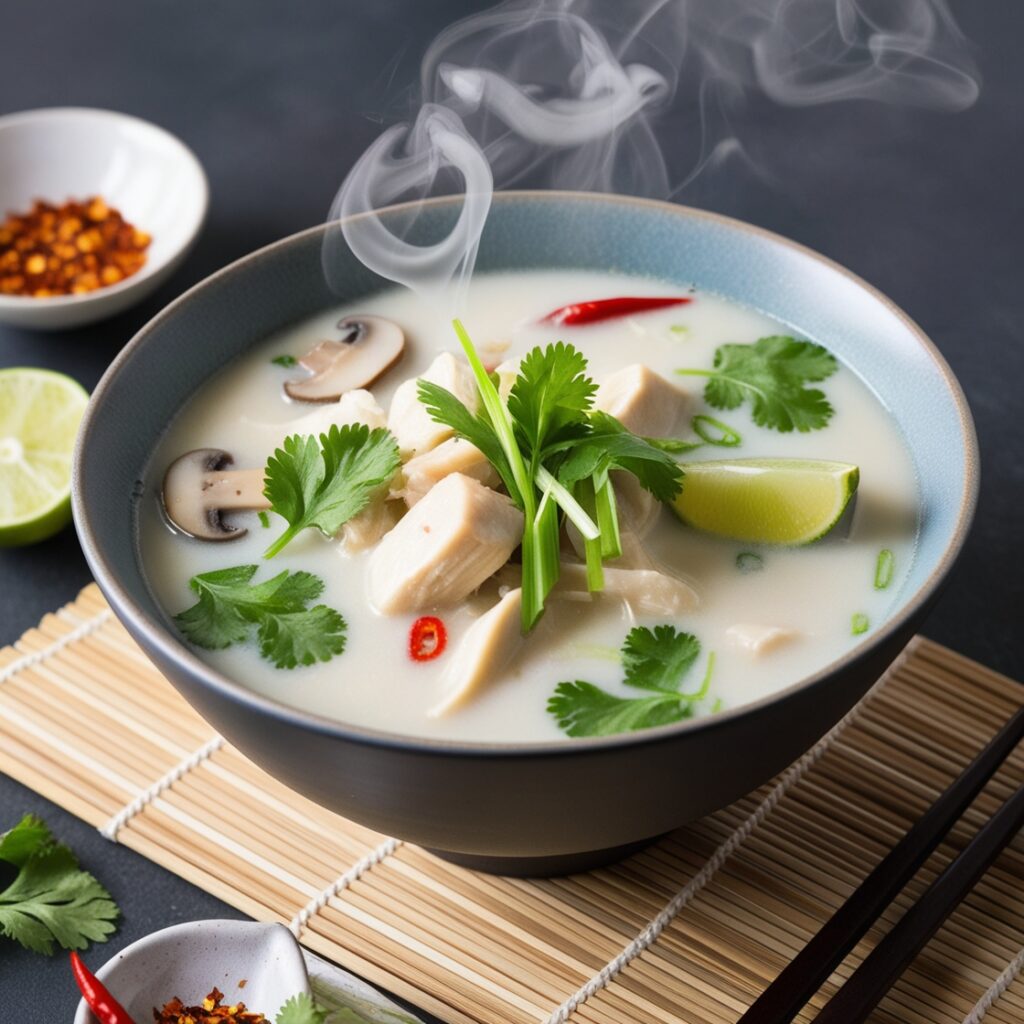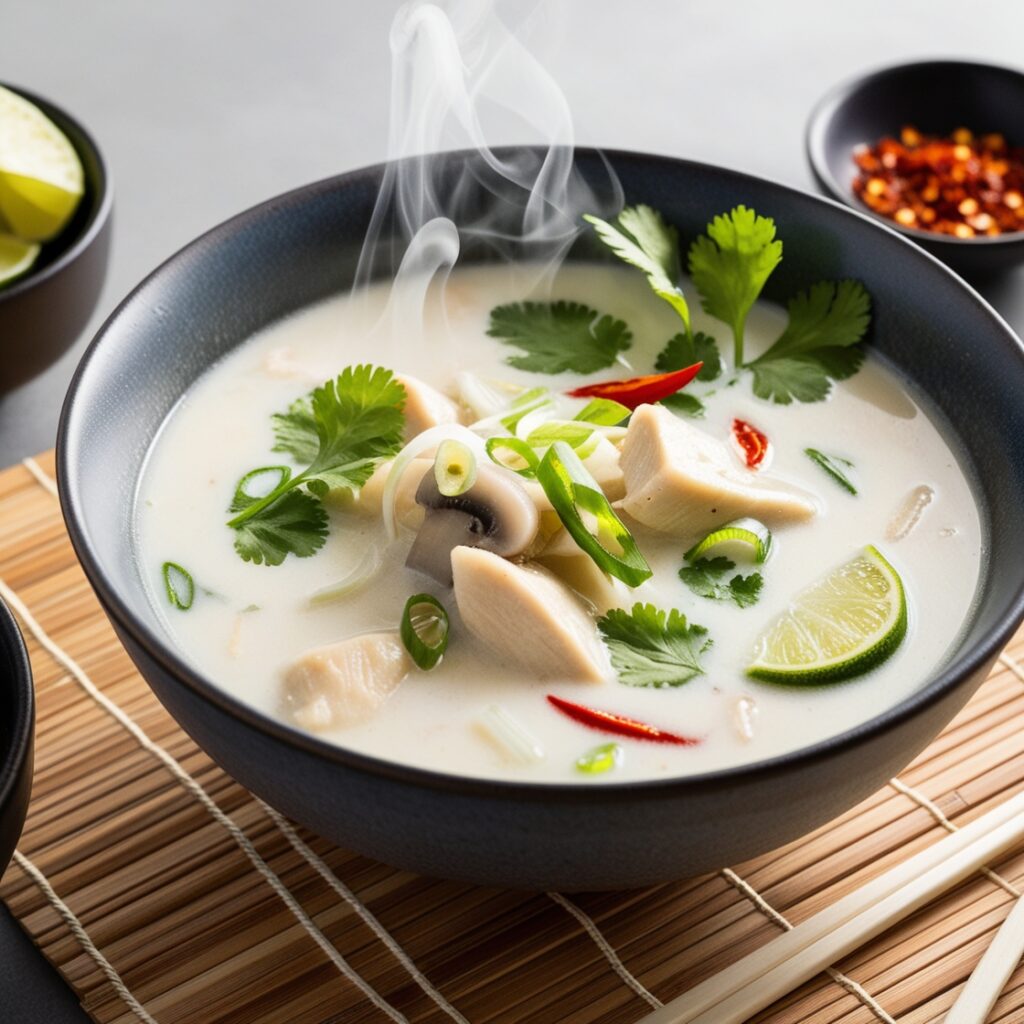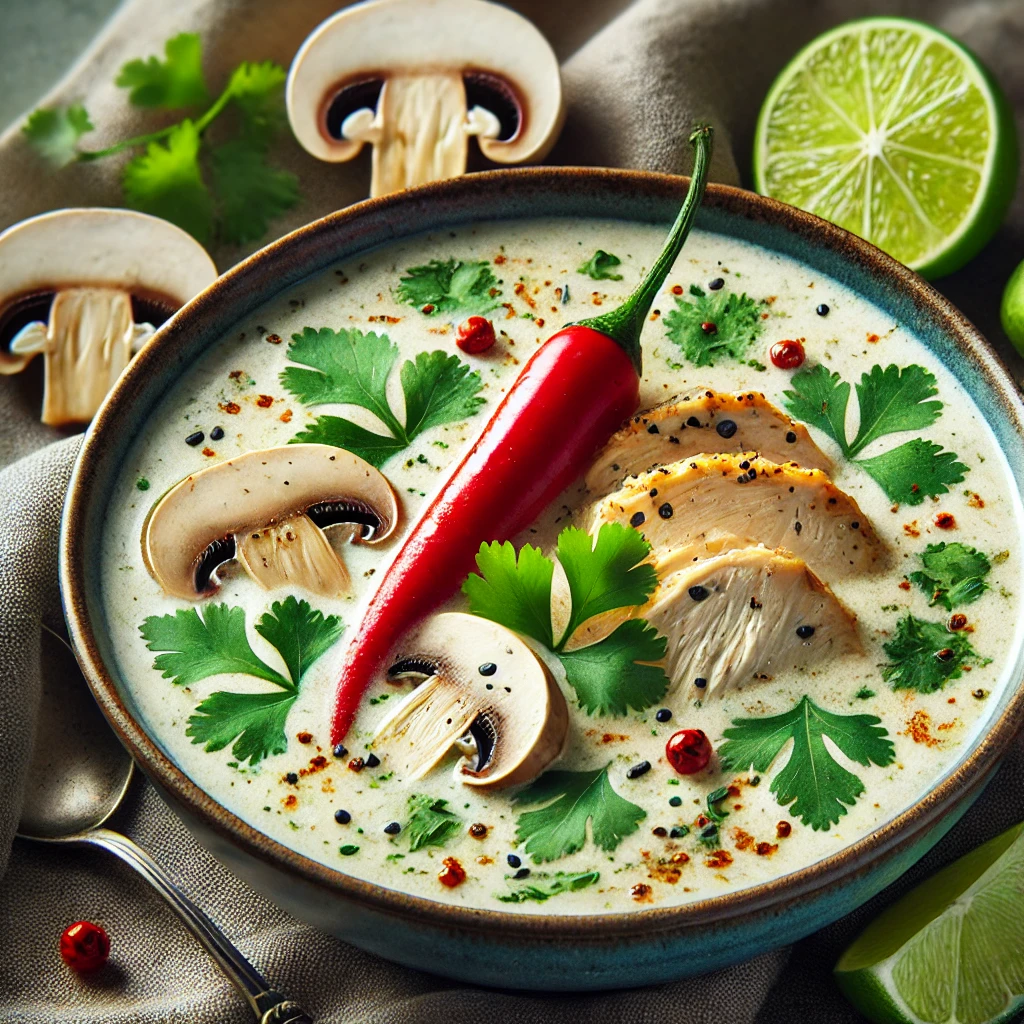Introduction:
Embark on a culinary journey to Thailand with this delectable Thai Coconut Chicken Soup, known as Tom Kha Gai. This iconic dish is a harmonious blend of rich, creamy coconut milk, aromatic spices, and fresh herbs, creating a complex flavor profile that perfectly balances sour, spicy, and creamy elements.
Loved by locals and food enthusiasts worldwide, Tom Kha Gai has become a staple in Thai cuisine, captivating taste buds with its irresistible combination of tender chicken, fragrant lemongrass, and zesty lime. Not only is this soup a treat for the senses, but it also boasts numerous health benefits thanks to ingredients like immune-boosting coconut milk, anti-inflammatory lemongrass, and antioxidant-rich lime.
Ingredients:
To recreate the authentic flavors of Thai Coconut Chicken Soup, you’ll need a handful of essential ingredients. Start with a can of creamy coconut milk, which serves as the foundation for the soup’s rich texture. Choose between tender chicken breast or thighs, depending on your preference. Fragrant lemongrass stalks, galangal (or ginger as a substitute), and kaffir lime leaves lend their unique aromas to the broth, while fiery Thai bird’s eye chilies add a spicy kick.
Mushrooms, such as button or shiitake, provide an earthy depth, while a generous squeeze of lime juice and a splash of fish sauce create the perfect balance of sour and salty flavors. Finally, a sprinkle of fresh cilantro adds a vibrant, herbaceous note. If you can’t find galangal, ginger makes an excellent substitute, and for a vegetarian version, simply replace the chicken with vegetable broth.
Step-by-Step Instructions:
Preparing Thai Coconut Chicken Soup is easier than you might think. Begin by creating a flavorful broth infused with the essence of lemongrass, galangal, and kaffir lime leaves. Gently bruise these aromatic ingredients and simmer them in the broth to release their flavors. Next, add the chicken pieces and allow them to cook until tender, ensuring they absorb the delightful flavors of the broth. Once the chicken is cooked, stir in the smooth coconut milk, sliced mushrooms, and a few fiery Thai bird’s eye chilies for a spicy kick. Simmer the soup gently, allowing the flavors to meld and the mushrooms to soften.

To achieve the perfect balance of salty and sour, add a generous splash of fish sauce and a squeeze of fresh lime juice. Taste the broth and adjust the seasoning to your liking—a little more fish sauce for saltiness or an extra squeeze of lime for tanginess. Just before serving, garnish the soup with a handful of fresh cilantro leaves for a pop of color and a burst of fresh flavor. The entire process takes around 30 minutes, making it a quick and satisfying meal option.
Health Benefits of Thai Coconut Chicken Soup:
Not only is Thai Coconut Chicken Soup a delight for the taste buds, but it also offers a range of health benefits. Coconut milk, a key ingredient in this dish, is rich in healthy fats that provide sustained energy and support the immune system. Lemongrass, another essential component, is known for its anti-inflammatory properties and ability to aid digestion, while lime juice is packed with vitamin C and antioxidants that help protect the body from harmful free radicals. This nourishing soup is naturally gluten-free and dairy-free, making it a suitable choice for those with dietary restrictions. By incorporating a variety of vitamins and minerals, Tom Kha Gai proves that delicious food can also be incredibly nutritious.
Recipe Variations:
One of the beauties of Thai Coconut Chicken Soup is its versatility. For a vegetarian version, simply substitute the chicken with firm tofu and replace the chicken stock with a flavorful vegetable broth. If you’re a seafood lover, try swapping the chicken for succulent shrimp or tender pieces of fish, transforming the dish into a tantalizing seafood delight. For those who crave an extra spicy kick, add a few more bird’s eye chilies or a dollop of fiery Thai chili paste to amp up the heat. Don’t be afraid to experiment with different vegetables, too—baby corn, sliced carrots, or crunchy bamboo shoots can add delightful texture and flavor to your bowl of Tom Kha Gai.
Serving Suggestions:
Thai Coconut Chicken Soup is a versatile dish that can be enjoyed in various ways. For a complete meal, serve the soup alongside a steaming bowl of fragrant jasmine rice or sticky rice, allowing the grains to soak up the creamy, flavorful broth. Pair your Tom Kha Gai with fresh spring rolls or a zesty Thai salad for a light and refreshing contrast to the rich soup. This dish can be served as a satisfying appetizer to kick off a Thai-inspired feast or as a comforting main course for a cozy night in.
Storing and Reheating:
If you find yourself with leftovers, storing Thai Coconut Chicken Soup is a breeze. Simply transfer the cooled soup to an airtight container and store it in the refrigerator for up to 3 days. When you’re ready to enjoy it again, reheat the soup gently over medium heat, stirring occasionally to prevent the coconut milk from curdling. If you plan on freezing the soup, it’s best to do so without the coconut milk and add it fresh when reheating to maintain the creamy texture and avoid any separation.
Conclusion:
Thai Coconut Chicken Soup (Tom Kha Gai) is a true celebration of flavors, showcasing the best of Thai cuisine in a single bowl. With its creamy coconut base, aromatic herbs, and tender chicken, this soup is a comforting and indulgent treat that will transport your taste buds to the vibrant streets of Thailand.

By following this easy recipe and adding your own personal twists, you’ll soon be savoring the authentic flavors of Tom Kha Gai in the comfort of your own home. So gather your ingredients, fire up the stove, and get ready to embark on a culinary adventure that will leave you craving more. Don’t forget to share your experience and any creative variations in the comments below—we can’t wait to hear how you’ve made this classic Thai dish your own!
1. What ingredients do I need for Thai coconut chicken soup?
To make Thai coconut chicken soup, you’ll need coconut milk, chicken (breast or thigh), chicken broth, lemongrass, ginger or galangal, garlic, lime juice, fish sauce, Thai red curry paste, and vegetables like mushrooms or baby corn. Fresh herbs like cilantro and Thai basil add extra flavor.
2. Can I make Thai coconut chicken soup spicy?
Yes, to make it spicy, add more Thai red curry paste or fresh chili peppers like Thai bird chilies. You can also serve chili oil or crushed red pepper flakes on the side for individual customization.
3. Can I make Thai coconut chicken soup vegetarian?
Yes, you can easily make a vegetarian version by replacing the chicken with tofu or mushrooms and using vegetable broth instead of chicken broth. Leave out the fish sauce and use soy sauce or tamari as a substitute.
4. What can I serve with Thai coconut chicken soup?
Thai coconut chicken soup pairs well with jasmine rice or sticky rice. You can also serve it with a side of fresh spring rolls or a Thai-inspired salad to complement the flavors.
5. Can I use light coconut milk in Thai coconut chicken soup?
Yes, light coconut milk can be used if you want a lower-fat option. However, keep in mind that the soup may be less creamy and rich compared to using full-fat coconut milk.
6. How do I store and reheat Thai coconut chicken soup?
Store leftover soup in an airtight container in the refrigerator for up to 3-4 days. Reheat it gently on the stovetop over medium heat, stirring occasionally, to preserve the creamy texture of the coconut milk.
7. Can I freeze Thai coconut chicken soup?
Yes, Thai coconut chicken soup freezes well. Store it in an airtight, freezer-safe container for up to 3 months. To reheat, thaw it in the fridge overnight and warm it up on the stovetop. Note that the coconut milk may separate slightly after freezing, but stirring the soup will help restore its texture.
8. What can I use instead of fish sauce in Thai coconut chicken soup?
If you don’t have fish sauce or prefer a substitute, you can use soy sauce or tamari for a similar salty, umami flavor. You can also use a combination of soy sauce and a little lime juice for extra tanginess.
9. Can I add noodles to Thai coconut chicken soup?
Yes, adding noodles like rice noodles or vermicelli can make the soup more filling. Cook the noodles separately and add them to individual servings to prevent them from soaking up too much broth.
10. How do I make Thai coconut chicken soup more flavorful?
To enhance the flavor, be sure to use fresh lemongrass, ginger (or galangal), and lime juice. You can also simmer the soup longer to deepen the flavors, or add a dash of sugar to balance the spiciness and tanginess of the broth.

